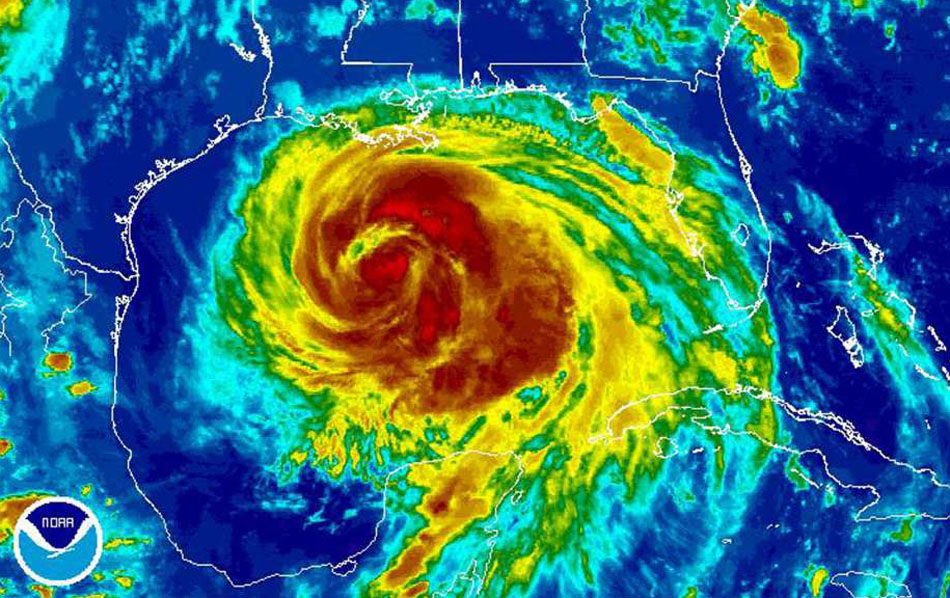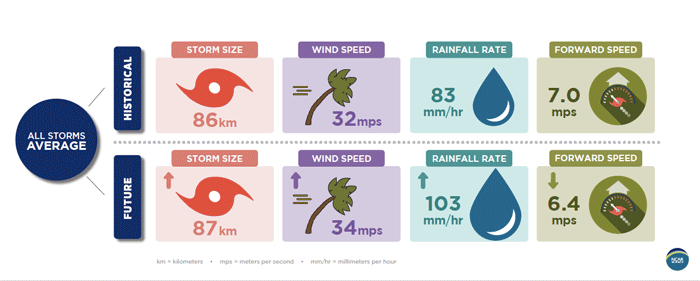Hurricanes: A bit stronger, a bit slower, and a lot wetter in a warmer climate
New analysis compares 22 named storms with their future selves
May 21, 2018 - by Laura Snider
May 21, 2018 - by Laura Snider

A satellite image of Hurricane Ike from Sept. 11, 2008. (Image: NOAA)
BOULDER, Colo. — Scientists have published a detailed analysis of how 22 recent hurricanes would change if they instead formed near the end of this century. While each storm's transformation would be unique, on balance, the hurricanes would become a little stronger, a little slower moving, and a lot wetter.
In one example, Hurricane Ike — which killed more than 100 people and devastated parts of the U.S. Gulf Coast in 2008 — could have 13 percent stronger winds, move 17 percent slower, and be 34 percent wetter if it formed in a future, warmer climate.
Other storms could become slightly weaker (like Hurricane Ernesto) or move slightly faster (like Hurricane Gustav). None would become drier. The rainfall rate of simulated future storms in the study increased by an average of 24 percent.
The study, led by the National Center for Atmospheric Research (NCAR) and published in the Journal of Climate, compares high-resolution computer simulations of more than 20 historical, named Atlantic storms with a second set of simulations that are identical except for a warmer, wetter climate that is consistent with the average outcome of scientific projections for the end of this century.
"Our research suggests that future hurricanes could drop significantly more rain," said NCAR scientist Ethan Gutmann, who led the study. "Hurricane Harvey demonstrated last year just how dangerous that can be."
Harvey produced more than four feet of rain in some locations, breaking records and causing devastating flooding across the Houston area.
The research was funded by the National Science Foundation, which is NCAR's sponsor, and by DNV GL (Det Norske Veritas Germanischer Lloyd), a global quality assurance and risk management company.
With more people and businesses relocating near the coasts, the potential influence of climate change on hurricanes has significant implications for public safety and the economy. Last year's hurricane season, which caused an estimated $215 billion in losses according to Munich RE, was the costliest on record.
"This study shows that the number of strong hurricanes, as a percent of total hurricanes each year, may increase," said Ed Bensman, a program director in the National Science Foundation’s Division of Atmospheric and Geospace Sciences, which supported the study. "With increased development along coastlines, that has important implications for future storm damage."
It's been challenging for scientists to study how hurricanes may change in the future as the climate continues to warm. Most climate models, which are typically run on a global scale over decades or centuries, are not run at a high enough resolution to "see" hurricanes.
Most weather models, on the other hand, are run at a high enough resolution to accurately represent hurricanes, but they generally are not used to simulate long-term changes in climate due to the high cost of computational resources.
For the current study, the researchers took advantage of a massive new data set created at NCAR by running the Weather Research and Forecasting (WRF) model at a high resolution (4 kilometers, or about 2.5 miles) over the contiguous United States over two 13-year periods. The simulations took about a year to run at the NCAR-Wyoming Supercomputing Center in Cheyenne.
The first set of model runs simulates the weather as it unfolded between 2000–2013 and the second simulates the same weather patterns, but in a climate that is about 5 degrees Celsius (9 degrees Fahrenheit) hotter — the amount of warming expected by end of century if greenhouse gas emissions continue unabated.
The scientists created an algorithm to detect and track hurricanes within the vast amount of data. They identified 22 named storms that appear with very similar tracks in both the historic and future simulations, allowing them to be more easily compared.
As a group, the storms in the future simulation had 6 percent stronger average hourly maximum wind speeds than those in the past. They also moved at a 9 percent slower speed and had a 24 percent higher average hourly maximum rainfall rate. Average storm radius did not change.
But each storm was unique.
"Some past studies have also run WRF at a high resolution to study the impact of climate change on hurricanes, but those studies have tended to look at a single storm, like Sandy or Katrina," Gutmann said. "What we find looking at more than 20 storms is that some change one way, while others change in a different way. There is so much variability that you can't just study one storm and then extrapolate to all storms."
Still, there was one consistent feature across storms: They all produced more rain.
While the study sheds light on how a particular storm might look in a warmer climate, it doesn't provide insight into how global warming might affect storm genesis. That's because the hurricanes analyzed in this study formed outside of the region simulated by WRF and passed into the WRF simulation as fully formed storms.
Other research has suggested that fewer storms may form in the future due to increasing atmospheric stability or greater high-level wind shear, though the storms that do form are apt to be stronger.
"It's possible that in a future climate, large-scale atmospheric changes would make it so that some of these storms might never be able to form," Gutmann said. "But from this study we get an idea of what we can expect from the storms that do form."
The study co-authors include NCAR scientists Roy Rasmussen, Changhai Liu, Kyoko Ikeda, Cindy Bruyere, and James Done, as well as Luca Garrè, Peter Friis-Hansen, and Vidyynmala Veldore, all of DNV GL.
